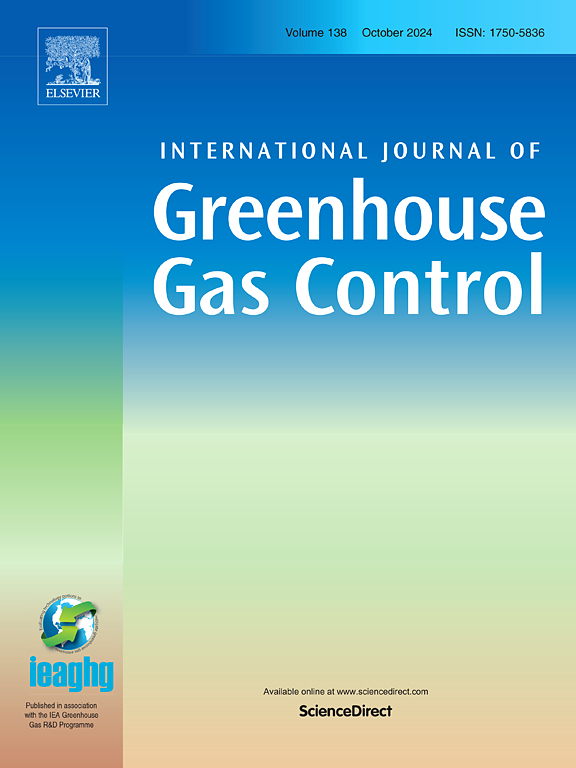对加州南部圣华金盆地一个潜在储气库现有油井和断层的二氧化碳泄漏进行评估
IF 5.2
3区 工程技术
Q2 ENERGY & FUELS
International Journal of Greenhouse Gas Control
Pub Date : 2025-04-21
DOI:10.1016/j.ijggc.2025.104381
引用次数: 0
摘要
演示了通过二氧化碳封存地点的现有井筒和断层(包括已存在、堵塞和废弃的井筒以及第四纪断层)进行二氧化碳泄漏评估的方案。在加利福尼亚州圣华金盆地南部的潜在含盐含水层地点的总注入量计划为 1230 万吨二氧化碳,在 18 年内每年的注入量不固定,并进行 100 年的监测。储层模拟优化了二氧化碳的注入,最大限度地减少了压力积聚和二氧化碳羽流的总体规模。羽流压力和饱和度历史输入到 NRAP-OPEN-IAM 的一个降阶模型中,以获得潜在泄漏率的分布。在泄漏评估过程中,为获得最坏情况下的估计值,堵塞井筒的渗透率被假定为很大(1 mD 到 10 mD)。断层被认为从地表一直延伸到储集区。渗漏到地下水位线的渗漏率可忽略不计,在背景预期范围内。据估计,118 年后,采用优化井方案的累计二氧化碳泄漏量与注入量之比在 0.0003% 到 0.001% 之间。此外,沿第四纪断层的泄漏率预计比现有井筒的泄漏率至少低一个数量级。由于井筒在二氧化碳和压力羽流中的相对位置不同,各种注入井轨迹方案的泄漏率也不同。在所有情况下,泄漏的二氧化碳量都远远低于注入量的 1%。本文章由计算机程序翻译,如有差异,请以英文原文为准。
Assessment of CO2 leakage through existing wells and faults for a prospective storage site in the Southern San Joaquin Basin, California
A protocol is demonstrated for assessment of CO2 leakage through existing wellbores and faults at CO2 storage sites including pre-existing, plugged-and-abandoned wellbores and Quaternary faults. Total injection at the prospective saline aquifer site in the southern San Joaquin Basin, CA is planned as 12.3 Mt CO2 with variable annual rates over 18 years followed by 100 years of monitoring. Reservoir simulation optimized CO2 injection by minimizing the pressure build-up and the overall size of the CO2 plume. The plume pressure and saturation history are input to one of the reduced order models in NRAP-OPEN-IAM to obtain distributions of potential leakage rates. During leakage assessment, the permeability of the plugged wellbores is assumed to be large (1 mD to 10 mD) to obtain worst-case estimates. Faults are considered to stretch from the surface to the storage zone. Leakage rates to the USDW are found to be negligible and within background expectations. The ratio of cumulative CO2 mass leaked to injected using the optimized well scenarios is estimated to range from 0.0003% to 0.001% after 118 years. Additionally, leakage rates along Quaternary faults are predicted to be at least an order of magnitude less compared to leakage from the existing wellbores. The various injection well trajectory scenarios show different leakage rates due to the relative location of wellbores within the CO2 and pressure plumes. In all cases, the amount of CO2 that leaks relative to what is injected is much less than 1%.
求助全文
通过发布文献求助,成功后即可免费获取论文全文。
去求助
来源期刊
CiteScore
9.20
自引率
10.30%
发文量
199
审稿时长
4.8 months
期刊介绍:
The International Journal of Greenhouse Gas Control is a peer reviewed journal focusing on scientific and engineering developments in greenhouse gas control through capture and storage at large stationary emitters in the power sector and in other major resource, manufacturing and production industries. The Journal covers all greenhouse gas emissions within the power and industrial sectors, and comprises both technical and non-technical related literature in one volume. Original research, review and comments papers are included.

 求助内容:
求助内容: 应助结果提醒方式:
应助结果提醒方式:


